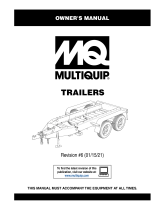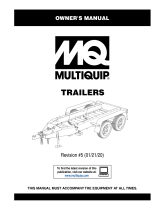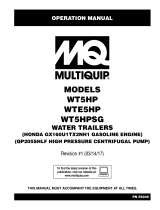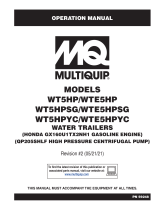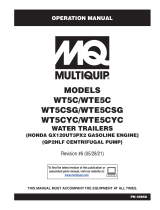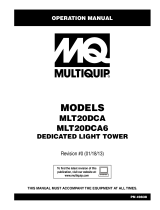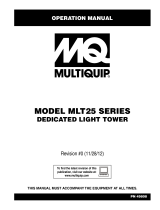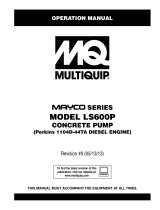Page is loading ...

OWNER'S MANUAL
THIS MANUAL MUST ACCOMPANY THE EQUIPMENT AT ALL TIMES.
To nd the latest revision of this
publication, visit our website at:
www.multiquip.com
TRAILERS
Revision #7 (09/12/23)

PAGE 2 — TRAILER • OWNER'S MANUAL — REV. #7 (9/12/23)
REPORTING SAFETY DEFECTS
If you believe that your vehicle has a defect that could cause a crash or could cause
injury or death, you should immediately inform the National Highway Traffic Safety
Administration (NHTSA) in addition to notifying Multiquip at 1-800-421-1244.
If NHTSA receives similar complaints, it may open an investigation, and if it finds
that a safety defect exists in a group of vehicles, it may order a recall and remedy
campaign. However, NHTSA cannot become involved in individual problems
between you, your dealer, or Multiquip.
To contact NHTSA, you may either call the Vehicle Safety Hotline toll-free at 1-888-
327-4236 (TTY: 1-800-424-9153), go to http://www.nhtsa.dot.gov; or write to:
Administrator
NHTSA
1200 New Jersey Avenue S.E.
Washington, DC 20590
You can also obtain information about motor vehicle safety from
http://www.safecar.gov.

TRAILER • OWNER'S MANUAL — REV. #7 (9/12/23) — PAGE 3
DISCLAIMER
DISCLAIMER STATEMENT
Multiquip publishes the technical information in this manual as an aid to its
customers and to the public. The information included in this manual is based
on sound engineering principles, research, extensive eld experience, and
technical judgments. This matter is subject to change in light of developments
in technology and eld experience. Use or adoption of the information contained
in this manual is voluntary. Multiquip disclaims any warranties or guaranties,
express or implied, in connection with the information in this manual. Further,
in our attempt to provide complete and comprehensive safety information on a
wide variety of trailers and trailer components, some of the information may or
may not apply to your particular trailer. Should there be any question regarding
your trailer’s components, construction or availability, please contact your dealer
or Multiquip.
IMPORTANT
Please read the supplied Owner's manual for operation and safety requirements.
Serious injury and/or property damage can result if the instructions and warnings
are not followed. Additional copies of the Owner's manual can be obtained from
your dealer or by contacting Multiquip. If you do not have any of the manuals
or instructions referred to in this manual, call Multiquip at 1-800-421-1244 for a
free copy.

PAGE 4 — TRAILER • OWNER'S MANUAL — REV. #7 (9/12/23)
TABLE OF CONTENTS
Trailer Owner's Manual
Reporting Safety Defects ...................................... 2
Disclaimer .............................................................. 3
Table Of Contents ............................................... 4-5
Safety Information .............................................. 6-8
Safety Messages .................................................. 6
General Safety...................................................... 7
Fuel Safety ........................................................... 7
Towing Safety ....................................................... 7
Battery Safety ....................................................... 8
Trailer Component Identication ......................... 9
Safety Guidelines ........................................... 10-16
Loss Of Control................................................... 10
Driving Too Fast ............................................... 10
Failure To Adjust Handling While Towing ......... 10
Trailer Not Properly Coupled To Hitch ............. 10
Incorrect Use Of Safety Chains ........................11
Incorrect Use Of Breakaway Brake ..................11
Mismatch Of Trailer And Hitch ..........................11
Unsafe Tires, Lug Nuts Or Wheels ...................11
Overloading The Trailer ................................... 12
Unsafe Load Distribution ................................. 12
Shifting Cargo .................................................. 13
Inappropriate Cargo ........................................ 13
Inoperable Brakes, Lights Or Mirrors .............. 13
Hazards From Modifying Your Trailer ................. 14
Hazards From Accessories................................. 14
Generators ...................................................... 14
Safety Warning Decals On Your Trailer .............. 14
Trailer Towing Tips .............................................. 14
Trailer Towing Guidelines ................................... 15
Coupling To The Tow Vehicle ........................ 17-26
Trailer Vin Tag ..................................................... 17
Tow Vehicle......................................................... 18
Carrying And Towing Capacity Of Vehicle ....... 18
Towing Hitch .................................................... 18
Suspension System ......................................... 18
Brake Controller .............................................. 18
Side View Mirrors ............................................ 18
Heavy Duty Flasher ......................................... 18
Electrical Connector ........................................ 18
Heavy Duty Engine Oil Cooling System .......... 18
Automatic Transmission Oil Cooler ................. 18
Fire Extinguisher ............................................. 18
Emergency Flares And Triangle Reectors ..... 18
Trailer ................................................................. 19
Coupler ............................................................ 19
Hitch ................................................................ 19
Safety Chains .................................................. 19
Trailer Lighting And Braking Connector ........... 19
Breakaway System .......................................... 19
Jackstand ........................................................ 19
Coupler Types .................................................... 19
Ball Coupler ..................................................... 20
Pintle-Eye Coupler .......................................... 20
Fifth-Wheel Kingpin ......................................... 20
Coupling Trailer To Tow Vehicle .......................... 20
Preparing The Coupler And Hitch .................... 21
Trailer Coupler To Tow Vehicle Hitch ............... 21
Attaching Safety Chains .................................. 22
Breakaway Brake System ............................... 22
Connecting The Electrical Cables ................... 23
Uncoupling Hitch With Tongue Jack ................ 23
Coupling Trailer To Tow Vehicle(Fifth Wheel) ..... 24
Preparing The Fifth Wheel Kingpin .................. 24
Trailer Kingpin To Tow Vehicle Fifth Wheel ...... 24
Raise The Drop-Leg Jack ................................ 25
Breakaway Brake System ............................... 25
Connecting The Electrical Cables ................... 25
Uncoupling Fifth-Wheel ................................... 25
Proper Level Of Trailer ....................................... 26
Loading The Trailer ........................................ 27-28
Tongue Weight .................................................... 27
Checking Tongue Weight .................................... 28
Securing The Cargo ........................................... 28
Pre-Tow Checklist ............................................... 28
Make Regular Stops ........................................... 28
Transporting A Trailer ......................................... 29
Breaking In A New Trailer ................................... 30
Retighten Lug Nuts ............................................. 30
Adjust Brake Shoes At First 200 Miles ............... 30
Synchronizing The Brake Systems .................... 30

TRAILER • OWNER'S MANUAL — REV. #7 (9/12/23) — PAGE 5
TABLE OF CONTENTS
Accessories ......................................................... 31
Diesel And Gasoline Fueled Generators ............ 31
Vending And Accessory Doors ........................... 31
Maintenance .................................................... 32-47
Axle Bolts, Frame, Suspension And Structure.... 34
Trailer Structure ............................................... 34
Welds ............................................................... 34
Fasteners ........................................................ 34
Suspension ...................................................... 35
Trailer Brakes ..................................................... 36
Manually Adjusting The Brakes .......................... 36
Hydraulic Brakes ................................................ 36
Air-Over-Hydraulic Brake System ...................... 36
Electric Brakes.................................................... 37
Electrical-Operated Hydraulic ............................. 37
Breakaway Brake ............................................... 37
Breakaway Battery .......................................... 37
Breakaway Switch ........................................... 37
Tow Vehicle Operated Electric Brakes............... 37
Actuator Maintenance......................................... 39
Hydraulic Actuator ........................................... 39
Electric Brake Adapter ..................................... 39
Adjustable Channel ......................................... 39
Ball Hitch Coupler ............................................... 40
Pintle Coupler And Pintle Hook .......................... 40
Gooseneck ......................................................... 40
Fifth Wheel Kingpin ............................................ 40
Tire Safety .......................................................... 41
Unsafe Tires, Lug Nuts Or Wheels .................. 41
Determining Load Limit Of Trailer .................... 41
Determining Load Limit Of Tow Vehicle ........... 42
Tire Fundamentals .............................................. 43
Uniform Tire Quality Grading Standards .......... 44
Tire Safety Tips ................................................ 44
Tire Repair ....................................................... 44
Replacing Worn Or Damaged Tires ................. 44
Wheel Rims ..................................................... 45
Wheels, Bearings And Lug Nuts ...................... 45
Lug Nut Torque Requirements ......................... 45
Lights And Signals ........................................... 46
Storage Preparation ........................................... 47
Inspection after prolonged storage ..................... 47
GLOSSARY OF TERMS .................................. 48-50
NOTICE
Specications and part numbers are subject to change
without notice.

PAGE 6 — TRAILER • OWNER'S MANUAL — REV. #7 (9/12/23)
SAFETY INFORMATION
Do not operate or service the equipment before reading the
entire manual. Safety precautions should be followed at all
times when operating this equipment. Failure to read and
understand the safety messages and operating instructions
could result in injury to yourself and others.
SAFETY MESSAGES
The four safety messages shown below will inform you
about potential hazards that could injure you or others. The
safety messages specically address the level of exposure
to the operator and are preceded by one of four words:
DANGER, WARNING, CAUTION or NOTICE.
SAFETY SYMBOLS
Potential hazards associated with the operation of this
equipment will be referenced with hazard symbols which
may appear throughout this manual in conjunction with
safety messages.
DANGER
Indicates a hazardous situation which, if not avoided,
WILL result in DEATH or SERIOUS INJURY.
WARNING
Indicates a hazardous situation which, if not avoided,
COULD result in DEATH or SERIOUS INJURY.
CAUTION
Indicates a hazardous situation which, if not avoided,
COULD result in MINOR or MODERATE INJURY.
NOTICE
Addresses practices not related to personal injury.
Lethal exhaust gas hazards
Explosive fuel hazards
Burn hazards
Rotating parts hazards
Symbol Safety Hazard

TRAILER • OWNER'S MANUAL — REV. #7 (9/12/23) — PAGE 7
SAFETY INFORMATION
GENERAL SAFETY
CAUTION
NEVER operate this equipment without proper protective
clothing, shatterproof glasses, respiratory protection,
hearing protection, steel-toed boots and other protective
devices required by the job or city and state regulations.
NEVER operate this equipment when not
feeling well due to fatigue, illness or when
under medication.
NEVER operate this equipment under the inuence of
drugs or alcohol.
ALWAYS check the equipment for loosened threads or
bolts before starting.
DO NOT use the equipment for any purpose other than
its intended purposes or applications.
NOTICE
This equipment should only be operated by trained and
qualied personnel 18 years of age and older.
Whenever necessary, replace nameplate, operation and
safety decals when they become difcult read.
Manufacturer does not assume responsibility for any
accident due to equipment modications. Unauthorized
equipment modication will void all warranties.
NEVER use accessories or attachments that are not
recommended by Multiquip for this equipment. Damage
to the equipment and/or injury to user may result.
ALWAYS know the location of the nearest
re extinguisher.
ALWAYS know the location of the nearest
rst aid kit.
ALWAYS know the location of the nearest phone or keep
a phone on the job site. Also, know the phone numbers
of the nearest ambulance, doctor and re department.
This information will be invaluable in the case of an
emergency.
FUEL SAFETY
DANGER
DO NOT start the engine near spilled fuel or combustible
uids. Diesel fuel is extremely ammable and its vapors
can cause an explosion if ignited.
ALWAYS refuel in a well-ventilated area, away from
sparks and open ames.
ALWAYS use extreme caution when working with
ammable liquids.
DO NOT ll the fuel tank while the engine is running
or hot.
DO NOT overll tank, since spilled fuel could ignite if it
comes into contact with hot engine parts or sparks from
the ignition system.
Store fuel in appropriate containers, in well-ventilated
areas and away from sparks and ames.
NEVER use fuel as a cleaning agent.
DO NOT smoke around or near the
equipment. Fire or explosion could result
from fuel vapors or if fuel is spilled on a
hot engine.
TOWING SAFETY
CAUTION
Check with your local county or state safety
towing regulations, in addition to meeting
Department of Transportation (DOT)
Safety Towing Regulations, before towing
your generator.
In order to reduce the possibility of an accident while

PAGE 8 — TRAILER • OWNER'S MANUAL — REV. #7 (9/12/23)
SAFETY INFORMATION
transporting the generator on public roads, ALWAYS
make sure the trailer and the towing vehicle are
mechanically sound and in good operating condition.
ALWAYS shutdown engine before transporting.
Make sure the hitch and coupling of the towing vehicle
are rated equal to, or greater than the trailer “gross
vehicle weight rating.”
ALWAYS inspect the hitch and coupling for wear. NEVER
tow a trailer with defective hitches, couplings, chains, etc.
Check the tire air pressure on both towing vehicle and
trailer. Trailer tires should be inated to 50 psi cold.
Also check the tire tread wear on both vehicles.
ALWAYS make sure the trailer is equipped with a safety
chain.
ALWAYS properly attach trailer’s safety chains to towing
vehicle.
ALWAYS make sure the vehicle and trailer directional,
backup, brake and trailer lights are connected and
working properly.
DOT Requirements include the following:
• Connect and test electric brake operation.
• Secure portable power cables in cable tray with tie
wraps.
The maximum speed for highway towing is 55 MPH unless
posted otherwise. Recommended off-road towing is not
to exceed 15 MPH or less depending on type of terrain.
Avoid sudden stops and starts. This can cause skidding,
or jack-kning. Smooth, gradual starts and stops will
improve towing.
Avoid sharp turns to prevent rolling.
Trailer should be adjusted to a level position at all times
when towing.
Raise and lock trailer wheel stand in up position when
towing.
Place chock blocks underneath wheel to prevent
rolling while parked.
Place support blocks underneath the trailer’s bumper
to prevent tipping while parked.
Use the trailer’s swivel jack to adjust the trailer height to
a level position while parked.
BATTERY SAFETY
DANGER
DO NOT drop the battery. There is a possibility that the
battery will explode.
DO NOT expose the battery to open ames,
sparks, cigarettes, etc. The battery contains
combustible gases and liquids. If these
gases and liquids come into contact with a
ame or spark, an explosion could occur.
WARNING
ALWAYS wear safety glasses when
handling the battery to avoid eye irritation.
The battery contains acids that can cause
injury to the eyes and skin.
Use well-insulated gloves when picking up the battery.
ALWAYS keep the battery charged. If the battery is not
charged, combustible gas will build up.
ALWAYS recharge the battery in a well-ventilated
environment to avoid the risk of a dangerous concentration
of combustible gasses.
If the battery liquid (dilute sulfuric acid) comes into
contact with clothing or skin, rinse skin or clothing
immediately with plenty of water.
If the battery liquid (dilute sulfuric acid) comes into
contact with eyes, rinse eyes immediately with plenty
of water and contact the nearest doctor or hospital to
seek medical attention.
CAUTION
ALWAYS disconnect the NEGATIVE battery terminal
before performing service on the generator.
ALWAYS keep battery cables in good working condition.
Repair or replace all worn cables.

TRAILER • OWNER'S MANUAL — REV. #7 (9/12/23) — PAGE 9
TRAILER COMPONENT IDENTIFICATION
Figure 1 represents typical trailer components. Although there are many variations, styles, and congurations of these
components, i.e. frame types, number of axles, integrated fuel tanks, hydraulic or electric brake actuators, jacks and hub
sizes, the basic function of these components is the same on most trailers. As an aid to the user, Multiquip has attempted to
identify a variety of trailer components in this manual, some of which are not typically found on trailers that are manufactured
by Multiquip. To assure proper use and safety, ALWAYS refer to the component manufacturer’s owner's manual before use.
Figure 1. Trailer Components

PAGE 10 — TRAILER • OWNER'S MANUAL — REV. #7 (9/12/23)
SAFETY GUIDELINES
This owner's manual provides general trailer information
but cannot cover all of the specic details necessary for
the proper combination of every trailer, tow vehicle and
hitch. Therefore, you must read, understand and follow
the instructions given by the tow vehicle and trailer hitch
manufacturers, in addition to the instructions in this manual.
Safety precautions should be followed at all times when
operating this equipment. Failure to read, understand and
follow the Operating Instructions could result in injury to
yourself and others.
LOSS OF CONTROL
Loss of control of the trailer or trailer/tow vehicle
combination can result in death or serious injury. The most
common causes for loss of control of the trailer are:
Driving too fast for the conditions (maximum speed when
towing a trailer is 60 mph)
Failure to adjust handling while towing with a trailer
Trailer not properly coupled to the hitch
Incorrect use of safety chains
Incorrect use of breakaway brake
Mismatch of trailer and hitch
Unsafe tires, lug nuts or wheels
Overloading the trailer
Unsafe load distribution
Shifting or inappropriate cargo
Inoperable brakes, lights or mirrors
Driving Too Fast
Even under ideal road and weather conditions, never drive
faster than what is safe. Remember, if you drive too fast,
the trailer tires will overheat and possibly blowout. As your
speed increases, you are more likely to suddenly lose
control. Check for local trailer tow speed limits in your area.
WARNING
Driving too fast for conditions can result in loss of
control and cause death or serious injury. Decrease
your speed as road, weather and lighting conditions
deteriorate.
Failure to Adjust Handling While Towing
When towing a trailer, you will have decreased acceleration,
increased stopping distance, and increased turning radius
(which means you must make wider turns to keep from
hitting curbs, vehicles, and anything else that is on the
inside corner). In addition, you will need a longer distance
to pass, due to slower acceleration and increased length.
Be alert for slippery conditions. You are more likely to
be affected by slippery road surfaces when driving a tow
vehicle with a trailer than driving a tow vehicle without
a trailer.
Anticipate the trailer “swaying.” Swaying is the trailer
reaction to the air pressure wave caused by passing
trucks and buses. Continued pulling of the trailer
provides a stabilizing force to correct swaying. Do not
apply the brakes to correct trailer swaying.
Check rearview mirrors frequently to observe the trailer
and trafc.
Use lower gear when driving down steep or long grades.
Use the engine and transmission as a brake. Do not ride
the brakes, as they can overheat and become ineffective.
Be aware of your trailer height, especially when
approaching roofed areas and around trees.
Trailer Not Properly Coupled to Hitch
It is critical that the trailer be securely coupled to the hitch
and that the safety chains are correctly attached.
WARNING
A loss of coupling may result in death or serious injury.
• Be sure the hitch load rating is equal to or greater
than the load rating of the coupler.
• Be sure the hitch size matches the coupler size.
• Observe the hitch for wear, corrosion and cracks
before coupling. Replace worn, corroded or
cracked hitch components before coupling the
trailer to the tow vehicle.
• Be sure the hitch components are tight before
coupling the trailer to the tow vehicle.

TRAILER • OWNER'S MANUAL — REV. #7 (9/12/23) — PAGE 11
Incorrect Use of Safety Chains
Multiquip trailers are equipped with safety chains so control
of the trailer can still be maintained even if the trailer comes
loose from the hitch. It is important to always connect the
safety chains and for maximum effectiveness, ensure they
are properly rigged.
Incorrect Use of Breakaway Brake
Multiquip trailers are equipped with a breakaway brake
system that can apply the brakes on your trailer, if for
any reason your trailer comes loose from the hitch. You
will have a separate set of instructions for the breakaway
brake system. The safety chains and breakaway brake
system must be in good condition and properly rigged to
be effective.
WARNING
Improper rigging of the safety chains can result in
loss of control of the trailer and tow vehicle, leading
to death or serious injury, if the trailer uncouples from
the tow vehicle.
• Fasten chains to frame of tow vehicle. Do not fasten
chains to any part of the hitch unless the hitch has
holes or loops specically for that purpose.
• Cross chains underneath hitch and coupler with
enough slack to permit turning and to hold tongue
up, if the trailer comes loose.
WARNING
An ineffective or inoperative breakaway brake system
can result in a runaway trailer, leading to death or
serious injury, if the coupler or hitch fails.
The breakaway cable must be connected to the tow
vehicle; and NOT to any part of the hitch.
Before towing the trailer, test the function of the
breakaway brake system. If the breakaway brake
system is not working, do not tow the trailer; have it
serviced or repaired.
SAFETY GUIDELINES
Mismatch of Trailer and Hitch
Be sure your hitch and tow vehicle are rated for the Gross
Vehicle Weight Rating (GVWR) of your trailer.
Unsafe Tires, Lug Nuts or Wheels
Trailer tires and wheels are more likely to fail than car tires
and wheels because they carry a heavier load. Therefore,
it is essential to inspect the trailer tires before each tow.
If a tire has a bald spot, bulge, cuts, is showing any cords,
or is cracked, replace the tire before towing. If a tire has
uneven tread wear, take the trailer to a dealer service
center for diagnosis. Uneven tread wear can be caused
by tire imbalance, axle misalignment or incorrect ination.
Tires with too little tread will not provide adequate tracking
on wet roadways and can result in loss of control, leading
to death or serious injury.
Improper tire pressure causes an unstable trailer and
can result in a tire blowout and loss of control. Therefore,
before each tow you must also check the tire pressure.
Tire pressure must be checked when tires are cold. Allow 3
hours cool-down after driving as much as 1 mile at 40 mph
before checking tire pressure. NOTE: Trailer tires will be
inated to higher pressures than passenger vehicle tires.
DANGER
Use of a hitch with a load rating less than the load rating
of the trailer can result in loss of control and may lead
to death or serious injury.
Use of a tow vehicle with a towing capacity less than
the load rating of the trailer can result in loss of control,
and may lead to death or serious injury..
WARNING
Improper tire pressure can result in a blowout and loss
of control, which can lead to death or serious injury.
Be sure tires are inated to pressure indicated on side
wall before towing trailer.

PAGE 12 — TRAILER • OWNER'S MANUAL — REV. #7 (9/12/23)
Since trailer wheels and lug nuts (or bolts) are subjected
to greater side loads than automobile wheels, they are
more prone to loosen. Before each tow, check to make
sure they are tight.
Use a torque wrench to tighten the lug nuts. If you do not
have a torque wrench, use a lug wrench (from your tow
vehicle) and tighten the nuts as much as you can. Then
have a service garage or trailer dealer tighten the lug nuts
to the proper torque.
Lug nuts are also prone to loosen after first being
assembled. When driving a new trailer (or after wheels
have been remounted), check to make sure they are tight
after the rst 10, 25 and 50 miles of driving and before
each tow thereafter.
Overloading The Trailer
The total weight of the load you put in or on the trailer, plus
the empty weight of the trailer itself, must not exceed the
trailer’s Gross Vehicle Weight Rating (GVWR). If you do
not know the empty weight of the trailer, you must weigh it
at a commercial scale. In addition, you must distribute the
load in the trailer such that the load on any tire or axle does
not exceed the tire load rating or the Gross Axle Weight
Rating (GAWR).
WARNING
Metal creep between the wheel rim and lug nuts will
cause rim to loosen and could result in a wheel coming
off, leading to death or serious injury. Tighten lug nuts
before each tow.
WARNING
Lug nuts are prone to loosen after initial installation,
which can lead to death or serious injury.
Check lug nuts for tightness on a new trailer or when
wheel(s) have been remounted after the rst 10, 25
and 50 miles of driving.
WARNING
Improper lug nut torque can cause a wheel parting from
the trailer, leading to death or serious injury. Be sure
lug nuts are tight before each tow.
SAFETY GUIDELINES
Unsafe Load Distribution
Uneven load distribution can cause tire, wheel, axle or
structural failure. Be sure your trailer is properly loaded.
A proper weight distribution is equal, right to left. It creates
a tongue weight that is in the proper range for stable trailer
handling. For tandem and triple axle trailers, it is necessary
to know or check that no axle is overloaded.
In Table 1 below, the second column notes the rule-of-
thumb percentage of total weight of the trailer plus its cargo
(Gross Vehicle Weight or GVW) that should appear on the
tongue of the trailer.
For example, a trailer with a Ball Hitch or Bumper Hitch,
with a loaded weight of 10,000 pounds, should have
approximately 10-15% of 10,000 pounds (equivalent to
1,000 to 1,500 pounds) on the tongue.
WARNING
An overloaded trailer can result in loss of control of the
trailer, leading to death or serious injury.
Do not load a trailer so that the weight on any tire
exceeds its rating. Do not exceed the trailer Gross
Vehicle Weight Rating (GVWR) or the axle Gross Axle
Weight Rating (GAWR).
Table 1. Tongue Weight As A Percentage
of Loaded Trailer Weight
Type of Hitch Percentage
Ball Hitch (or Bumper Hitch) 10% - 15%
Pintle Eye Hitch 10% - 15%
Gooseneck Hitch 20% - 25%
Fifth Wheel Hitch 20% - 25%

TRAILER • OWNER'S MANUAL — REV. #7 (9/12/23) — PAGE 13
Towing stability also depends on keeping the center of
gravity as low as possible. Load heavy items on the oor,
and over the axles, but do not exceed the Gross Axle
Weight Rating (GAWR). When loading additional items,
be sure to maintain even side-to-side weight distribution
and proper tongue weight. Refer to the LOADING THE
TRAILER section of this manual for additional loading
information.
Shifting Cargo
Since the trailer “ride” can be bumpy and rough, you must
secure your cargo so that it does not shift while the trailer
is being towed.
Inappropriate Cargo
Multiquip trailers are designed for transporting specic
cargo. We recommend you carry only that cargo on the
trailer. A utility trailer must not be used to carry certain
items, such as people, containers of hazardous substances
or containers of ammable substances.
WARNING
Improper tongue weight (load distribution) can result in
loss of control of the trailer, leading to death or serious
injury. Make certain that tongue weight is within the
allowable range. Be sure to:
• Distribute the load front-to-rear to provide proper
tongue weight (see Table 1).
• Distribute the load evenly, right and left, to avoid tire
overload.
• Keep the center of gravity low.
WARNING
Shifting cargo can result in loss of control of the trailer,
and can lead to death or serious injury. Secure all loads
with proper sized fasteners, ropes, straps, bolts, etc.
WARNING
Do not transport people on the trailer. The transport of
people puts their lives at risk and may be illegal.
SAFETY GUIDELINES
Inoperable Brakes, Lights Or Mirrors
Be sure that the brakes and all of the lights on your trailer
are functioning properly before towing your trailer. Check
the trailer taillights by turning on your tow vehicle headlights.
Check the trailer brake lights by having someone step on
the tow vehicle brake pedal while you look at trailer lights.
Do the same thing to check the turn signal lights (see Trailer
Wiring Diagram).
If your trailer has electric brakes, your tow vehicle will have
an electric brake controller that sends power to the trailer
brakes. Before towing the trailer on the road, you must
operate the brake controller while trying to pull the trailer
in order to conrm that the electric brakes operate. While
towing the trailer at less than 5 mph, manually operate the
electric brake controller in the tow vehicle cab. You should
feel the operation of the trailer brakes.
Standard mirrors usually do not provide adequate visibility
for viewing trafc to the sides and rear of a towed trailer.
You must provide mirrors that allow you to safely observe
approaching trafc.
WARNING
Do not transport ammable, explosive, poisonous or
other dangerous materials in your trailer.
Exceptions:
• Fuel in the tanks of vehicles that are being towed
• Fuel stored in the tank of an on-board generator
WARNING
Improper electrical connection between the tow vehicle
and the trailer will result in inoperable lights and electric
brakes, and can lead to collision.
Before each tow:
• Check that the taillights, brake lights and turn signals
work.
• Check that the electric brakes work by operating the
brake controller inside the tow vehicle.

PAGE 14 — TRAILER • OWNER'S MANUAL — REV. #7 (9/12/23)
HAZARDS FROM MODIFYING YOUR TRAILER
Essential safety items can be damaged by altering your
trailer. Simply drilling a hole to secure an attaching bolt can
damage an electrical circuit, or other feature of the trailer.
Before making any alteration to your trailer, contact your
dealer or Multiquip at 1-800-421-1244 and describe
the alteration you are contemplating. Alteration of the
trailer structure or modication of mechanical, electrical,
plumbing, heating or other systems on your trailer must be
performed only by qualied technicians who are familiar
with the system as installed on your trailer.
HAZARDS FROM ACCESSORIES
This section contains some information about certain
optional accessories that may be on your trailer. Read
and follow all of these instructions before operating the
accessories.
Generators
If your trailer is equipped with a gasoline or diesel generator,
you must have and follow the generator manufacturer’s
instructions.
Carbon Monoxide is an odorless gas that can cause death.
Be certain exhaust from a running generator does not
accumulate in or around your trailer, by situations such as:
Being drawn in by fans or ventilators operated in a trailer.
Prevailing winds.
Being trapped between your trailer and other trailers,
vehicles or buildings.
Being trapped between your trailer and, or in a snowbank,
or other nearby objects.
WARNING
Operating gasoline and diesel generators can lead to
death or serious injury by:
• Carbon Monoxide
• Fire and Explosion
• Electrocution
Do not refuel a running generator or refuel near ignition
sources.
SAFETY WARNING DECALS ON YOUR TRAILER
Figure 2. Warning Decals and Locations
To protect you and others against death or serious injury,
warning decals (Figure 2) must be on the trailer and must
be legible.
If any of these labels are missing or cannot be read, call
Multiquip at 1-800-421-1244 for free replacement labels.
You will need to provide us with the number shown at the
bottom of the decal.
TRAILER TOWING TIPS
Driving a vehicle with a trailer in tow is vastly different
from driving the same vehicle without a trailer in tow.
Acceleration, maneuverability and braking are all
diminished with a trailer in tow.
It takes longer to get up to speed, you need more room to
turn and pass, and more distance to stop when towing a
trailer. You will need to spend time adjusting to the different
feel and maneuverability of the tow vehicle with a loaded
trailer.
SAFETY GUIDELINES

TRAILER • OWNER'S MANUAL — REV. #7 (9/12/23) — PAGE 15
Because of the signicant differences in all aspects of
maneuverability when towing a trailer, the hazards and risks
of injury are also much greater than when driving without
a trailer. You are responsible for keeping your vehicle and
trailer in control, and for all the damage that is caused if
you lose control of your vehicle and trailer.
As you did when learning to drive an automobile, nd
an open area with little or no trafc for your rst practice
trailering. Before you start towing the trailer, you must follow
all of the instructions for inspection, testing, loading and
coupling. Also, before you start towing, adjust the mirrors so
you can see the trailer as well as the area to the rear of it.
Drive slowly at rst, 5 mph or so, and turn the wheel to
get the feel of how the tow vehicle and trailer combination
responds. Next, make some right and left hand turns.
Watch in your side mirrors to see how the trailer follows
the tow vehicle. Turning with a trailer attached requires
more room.
Stop the rig a few times from speeds no greater than
10 mph. If your trailer is equipped with brakes, try using
different combinations of trailer brake and tow vehicle
brake. Note the effect that the trailer brakes have when
they are the only brakes used. When properly adjusted,
the trailer brakes will come on just before the tow vehicle
brakes.
It will take practice to learn how to back up a tow vehicle
with a trailer attached. Take it slow. Before backing up, get
out of the tow vehicle and look behind the trailer to make
sure that there are no obstacles.
Some drivers place their hands at the bottom of the steering
wheel, and while the tow vehicle is in reverse, “think” of the
hands as being on the top of the wheel. When the hands
move to the right (counterclockwise, as you would do to
turn the tow vehicle to the left when moving forward), the
rear of the trailer moves to the right. Conversely, rotating
the steering wheel clockwise with your hands at the bottom
of the wheel will move the rear of the trailer to the left while
backing up.
If you are towing a bumper hitch rig, be careful not to allow
the trailer to turn too much because it will hit the rear of the
tow vehicle. To straighten the rig, either pull forward or turn
SAFETY GUIDELINES
the steering wheel in the opposite direction.
TRAILER TOWING GUIDELINES
Recheck the load tiedowns to make sure the load will
not shift during towing.
Before towing, check coupling, safety chain, safety
brake, tires, wheels and lights.
Check the lug nuts or bolts for tightness.
Check coupler tightness after towing 50 miles.
Use your mirrors to verify that you have room to change
lanes or pull into trafc.
Use your turn signals well in advance.
Allow plenty of stopping space for your trailer and tow
vehicle.
DO NOT drive so fast that the trailer begins to sway
due to speed.
Allow plenty of room for passing. A rule of thumb is that
the passing distance with a trailer is 4 times the passing
distance without the trailer.
Shift your automatic transmission into a lower gear for
city driving.
ALWAYS use lower gears for climbing and descending
grades.
DO NOT ride the brakes while descending grades, they
may get so hot that they stop working. Then you will
potentially have a runaway tow vehicle and trailer.
To conserve fuel, don’t use full throttle to climb a hill.
Instead, build speed on the approach.
Slow down for bumps in the road. Take your foot off the
brake when crossing the bump.
DO NOT brake while in a curve unless absolutely
necessary. Instead, slow down before you enter the
curve and power through the curve. This way, the towing
vehicle remains in charge.
DO NOT apply the brakes to correct extreme trailer

PAGE 16 — TRAILER • OWNER'S MANUAL — REV. #7 (9/12/23)
swaying. Continued pulling of the trailer, and even slight
acceleration, will provide a stabilizing force.
Anticipate the trailer “swaying.” Swaying is the trailer
reaction to the air pressure wave caused by passing
trucks and buses. Continued pulling of the trailer
provides a stabilizing force to correct swaying. DO NOT
apply the brakes to correct trailer swaying.
Use lower gear when driving down steep or long grades.
Use the engine and transmission as a brake. DO NOT
ride the brakes, as they can overheat and become
ineffective.
Be aware of your trailer height, especially when
approaching roofed areas and around trees.
Make regular stops, about once each hour. Conrm that:
• Coupler is secure to the hitch and is locked.
• Electrical connectors are secure.
• There is appropriate slack in the safety
chains.
• There is appropriate slack in the breakaway
switch pull pin cable.
• Tires are not visibly low on pressure.
• The cargo is secure and in good condition.
SAFETY GUIDELINES

TRAILER • OWNER'S MANUAL — REV. #7 (9/12/23) — PAGE 17
Follow all of the safety precautions and instructions in this
manual to ensure safety of persons and equipment, and
satisfactory life of the trailer. Always use an adequate tow
vehicle and hitch. If the vehicle or hitch is not properly
selected and matched to the Gross Vehicle Weight Rating
(GVWR) of your trailer, you can cause an accident that
could lead to death or serious injury.
If you already have a tow vehicle, know your vehicle tow
rating and make certain the trailer’s rated capacity is less
than or equal to the tow vehicle’s rated towing capacity. If
you already have (or plan to buy) a trailer, make certain
that the tow rating of the tow vehicle is equal to or greater
than that of the trailer.
The trailer VIN tag contains the critical safety information
for the use of your trailer.
TRAILER VIN TAG
Figure 3 below is a sample of the Vehicle Identication
Number (VIN) Tag which is typically located on the left front
of the trailer. See Figure 4 for location.
Figure 3. Vehicle VIN Tag
WARNING
Proper selection and condition of the coupler and hitch
are essential to safely towing your trailer. A loss of
coupling may result in death or serious injury.
• Be sure the hitch load rating is equal to or greater
than the load rating of the coupler.
• Be sure the hitch size matches the coupler size.
• Observe the hitch for wear, corrosion and cracks
before coupling. Replace worn, corroded or cracked
hitch components before coupling the trailer to the
tow vehicle.
• Be sure the hitch components are tight before
coupling the trailer to the tow vehicle.
COUPLING TO THE TOW VEHICLE
Figure 4. VIN Tag Location
The trailer VIN tag contains the following critical safety
information for your trailer.
GAWR: The maximum gross weight that an axle can
support. It is the lowest of axle, wheel, or tire rating. Usually,
the tire or wheel rating is lower than the axle rating, and
determines GAWR.
GVWR: The maximum allowable gross weight of the trailer
and its contents. The gross weight of the trailer includes
the weight of the trailer and all of the items within it. GVWR
is sometimes referred to as GTWR (Gross Trailer Weight
Rating), or MGTW (Maximum Gross Trailer Weight).
GVWR, GTWR and MGTW are all the same rating.
The sum total of the GAWR for all trailer axles may be less
than the GVWR for the trailer, because some of the trailer
load is to be carried by the tow vehicle, rather than by the
trailer axle. The total weight of the cargo and trailer must
not exceed the GVWR, and the load on an axle must not
exceed its GAWR.
PSIC: The tire pressure (psi) measured when cold.
VIN: The Vehicle Identication Number.
EMPTY WEIGHT: Some information that comes with the
trailer (such as the Manufacturer’s Statement of Origin)
is not a reliable source for “empty” or “net” weight. The
shipping documents list average or standard weights and
your trailer may be equipped with options. xxcvcvc
VIN TAG
VIN TAG

PAGE 18 — TRAILER • OWNER'S MANUAL — REV. #7 (9/12/23)
To determine the “empty” or “net” weight of your trailer,
weigh it on an axle scale. To nd the weight of the trailer
using an axle scale, you must know the axle weights of
your tow vehicle without the trailer coupled. Some of the
trailer weight will be transferred from the trailer to the tow
vehicle axles, and an axle scale weighs all axles, including
the tow vehicle axles.
TOW VEHICLE
When equipping a new vehicle or an older vehicle to tow
your trailer, ask the vehicle dealer for advice on how to
outt the towing vehicle. Discuss the following information
and equipment with the vehicle dealer.
Overall Carrying and Towing Capacity of Vehicle
Vehicle manufacturers will provide you with the maximum
capacities of their various models. No amount of
reinforcement will give a 100 horsepower, 2,500 pound
truck the towing capacity that a 300 horsepower, 5,000
pound truck has.
Towing Hitch
The towing hitch attached to your tow vehicle must have
a capacity equal to or greater than the load rating of the
trailer you intend to tow. The hitch capacity must also be
matched to the tow vehicle capacity. Your vehicle dealer
can provide and install the proper hitch on your tow vehicle.
Suspension System
Sway bars, shock absorbers, heavy duty springs, heavy
duty tires and other suspension components may be
required to sufciently tow the trailer and pump.
Brake Controller
For trailers equipped with electric brakes, the electric brake
controller is part of the tow vehicle and is essential in the
operation of the electric brakes on the trailer. The brake
controller is not the same as the safety breakaway brake
system that may be equipped on the trailer.
Side View Mirrors
The size of the trailer that is being towed and your state
law regulations determine the size of the mirrors. However,
some states prohibit extended mirrors on a tow vehicle,
COUPLING TO THE TOW VEHICLE
except while a trailer is actually being towed. In this
situation, detachable extended mirrors are necessary.
Check with your dealer or the appropriate state agency
for mirror requirements.
Heavy Duty Flasher
A Heavy Duty Flasher is an electrical component that may
be required when your trailer turn signal lights are attached
to the tow vehicle asher circuit.
Electrical Connector
An Electrical connector connects the light and brake
systems on the trailer to the light and brake controls on
the towing vehicle.
Heavy Duty Engine Oil Cooling System
The tow vehicle engine works harder when a trailer is being
towed. Depending on the size of the trailer, you may need to
install a separate engine oil cooler. Inadequate cooling may
result in sudden engine failure. Ask the tow vehicle dealer
if it is necessary to install a heavy duty cooling system.
Automatic Transmission Oil Cooler
The automatic transmission of a towing vehicle handles
more power when a trailer is being towed. Inadequate
cooling will shorten transmission life, and may result in
sudden transmission failure. Ask the tow vehicle dealer
if it is necessary to install a separate oil cooler for the
automatic transmission.
Fire Extinguisher
Multiquip recommends maintaining access to a fire
extinguisher at all times.
Emergency Flares and Triangle Reectors
It is wise to carry these warning devices even if you are
not towing a trailer. It is particularly important to have these
when towing a trailer because the hazard ashers of your
towing vehicle will not operate for as long a period of time
when the battery is running both the trailer lights and tow
vehicle lights.

TRAILER • OWNER'S MANUAL — REV. #7 (9/12/23) — PAGE 19
COUPLING TO THE TOW VEHICLE
TRAILER
A secure coupling (or fastening) of the trailer to the tow
vehicle is essential. A loss of coupling may result in death
or serious injury. Therefore, you must understand and follow
all of the instructions for coupling.
The following parts are involved in making a secure
coupling between the trailer and tow vehicle:
Coupler
A device on the tongue of the trailer that connects to the
hitch device on the tow vehicle.
Hitch
A device on the tow vehicle that supports the weight of the
trailer tongue and pulls the trailer. The coupler attaches to
the hitch device.
Safety Chains
If the coupler connection comes loose, the safety chains
can keep the trailer attached to the tow vehicle. With
properly rigged safety chains, it is possible to keep the
tongue of the trailer from digging into the road pavement,
even if the coupler-to-hitch connection comes apart.
Trailer Lighting and Braking Connector
A device that connects electrical power from the tow vehicle
to the trailer. Electricity is used to turn on brake lights,
running lights, and turn signals as required. In addition, if
your trailer has a separate braking system, the electrical
connector will also supply power to the brakes from the
tow vehicle.
Breakaway System
If the trailer coupler connection comes loose, the breakaway
system can actuate emergency hydraulic brakes depending
on the type of actuator on the trailer. The breakaway cable
must be rigged to the tow vehicle with appropriate slack
that will activate the system if the coupler connection
comes loose.
Jackstand
A device on the trailer that is used to raise and lower the
coupler. The jack is sometimes called the “landing gear”
or the “tongue jack”.
Some trailers are equipped with swivel-type tongue jacks.
Swivel type tongue jacks are attached to the trailer frame
one to two feet behind the trailers coupler. Once the coupler
and hitch are secured, the jack can be swiveled parallel to
the trailer frame away from the roadway. This is achieved by
disengaging the pull pin located on the shaft that attaches
the jack to the trailer frame. Replace the pin once the jack
is in the desired position (Figure 5).
Figure 5. Swivel Tongue Jack
COUPLER TYPES
Trailers are produced with a variety of coupler devices.
Ball Coupler
Pintel-Eye Coupler
Fifth Wheel Kingpin
WARNING
NEVER position any part of your body underneath a
trailer being supported by the tongue jack. Serious
injury or death could occur if the jack should fail to
support the load. NEVER exceed maximum rated
capacity.
WARNING
Before using the swivel jack, make certain the pull pin
is fully inserted through both sides of the inner tube
and the trailer mount.
When operating the jack or coupling tow vehicle to
trailer, always secure the wheels of the trailer and tow
vehicle to prevent rolling.

PAGE 20 — TRAILER • OWNER'S MANUAL — REV. #7 (9/12/23)
Ball Coupler
A ball coupler (Figure 6) connects to a ball hitch that is
located on or under the rear bumper of tow vehicle. This
system of coupling a trailer to a tow vehicle is sometimes
referred to as “bumper pull.”
Figure 6. Ball Coupler
(Shown with Adjustable Channel)
When so equipped, Multiquip has utilized a ball coupler
that is suitable for the size and weight of the trailer. The
load rating of the coupler and the necessary ball size are
listed on the trailer tongue. You must provide a hitch for
your tow vehicle where the load rating of the hitch is equal
to or greater than that of your trailer. Also, the hitch ball
size must be the same as the coupler size.
Pintle-Eye Coupler
A pintle eye coupler (Figure 7) connects to a pintle-hook
hitch that is located on or under the rear bumper of tow
vehicle. This system of coupling a trailer to a tow vehicle
is sometimes referred to as a “lunette eye, tow ring or G.I.
hitch.”
Figure 7. Pintle-Eye Coupler
(Shown with Adjustable Channel)
BALL
COUPLER
ADJUSTABLE
CHANNEL
FLAT
WASHER
BOLT
NYLOC
NUT
ADJUSTABLE
CHANNEL
FLAT
WASHER
NYLOC
NUT
BOLT
PINTLE EYE
COUPLING TO THE TOW VEHICLE
Use a pintle-eye coupler that is suitable for the size and
weight of the trailer. The load rating of the coupler and the
necessary pintle hitch size are listed on the trailer tongue.
You must provide a pintle-hook hitch for your tow vehicle,
where the load rating of the pintle-hook hitch and pintle-
eye coupler is equal to or greater than that of your trailer.
Also, the hitch size must be the same as the coupler size.
Fifth-Wheel Kingpin
A kingpin on the trailer (Figure 8) connects to a fth wheel
installed in the bed of the tow vehicle. This system of
coupling a trailer to a tow vehicle has a greater tongue
weight capacity than a ball coupler.
Figure 8. Fifth Wheel Kingpin
Use a fth wheel kingpin that is suitable for the size and
weight of the trailer. The kingpin must match the fth
wheel,and rated for the Gross Vehicle Weight Rating
(GVWR) of your trailer.
COUPLING TRAILER TO TOW VEHICLE
(Ball and Pintle-Eye Couplers)
Make sure that the hitch is the same size as the coupler.
Couplers are marked with their size and rating.
Wipe the hitch ball clean and inspect it visually and by
feel for at spots, cracks and pits.
KINGPIN
NOTICE
THE TOW VEHICLE AND HITCH MUST HAVE
A RATED TOWING CAPACITY EQUAL TO OR
GREATER THAN THE TRAILER GROSS VEHICLE
WEIGHT RATING (GVWR).
WARNING
Coupler-to-hitch mismatch can result in uncoupling,
leading to death or serious injury.
/
